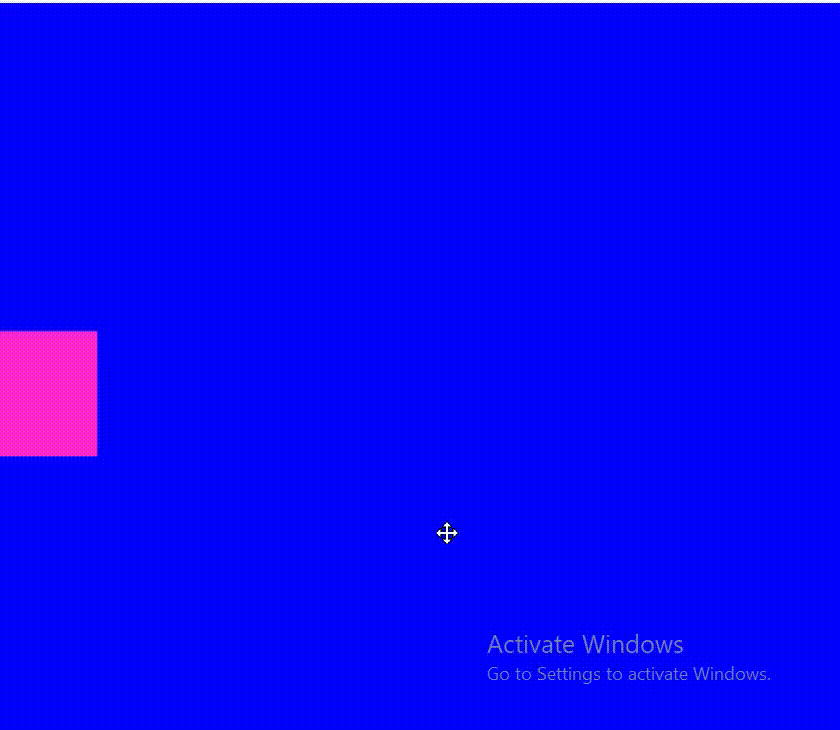函数loadShader()从文件加载着色器,并将其作为p5着色器对象返回到变量中。文件扩展名可以是.glsl或.shader或.vertex。
应该从preload()内调用它loadShader()。
用法:
loadShader(vertFilename, fragFilename, [callback], [errorCallback])
参数:
- vertFilename:它是字符串类型,并且包含包含顶点着色器源代码的文件的路径。
- fragFilename:它是字符串类型,它包含包含片段着色器源代码的文件的路径。
- callback:它是在loadShader完成后执行的函数。成功后,将将Shader对象作为第一个参数传递。它是可选的。
- errorCallback:这是在loadShader内部发生错误时执行的函数。如果有错误,则将错误作为第一个参数传递。它是可选的。
返回值:
从提供的顶点和片段着色器文件创建的着色器对象。
示例:此示例显示了如何使用着色器绘制正方形。
Javascript
// this variable will hold our shader object
let rectShader;
function preload(){
rectShader = loadShader('base.vert', 'rect.frag');
}
function setup() {
// shaders require WEBGL mode to work
createCanvas(400, 400, WEBGL);
noStroke();
}
function draw() {
// shader() sets the active shader with our shader
shader(rectShader);
// lets send the time and resolution to our shader
rectShader.setUniform('resolution', [width, height]);
rectShader.setUniform('time', frameCount * 0.1);
// rect gives us some geometry on the screen
rect(0,0,width, height);
}
function windowResized(){
resizeCanvas(windowWidth, windowHeight);
}base.vert
attribute vec3 aPosition;
attribute vec2 aTexCoord;
void main() {
// Copy the position data into a vec4, using
// 1.0 as the w component
vec4 positionVec4 = vec4(aPosition, 1.0);
// scale the rect by two, and move it to the
// center of the screen if we don't do this,
// it will appear with its bottom left corner
// in the center of the sketch try commenting
// this line out to see what happens
positionVec4.xy = positionVec4.xy * 2.0 - 1.0;
// Send the vertex information on to the fragment shader
gl_Position = positionVec4;
}直肠片段
<pre>precision mediump float;
varying vec2 vTexCoord;
// We need the sketch resolution to perform
// some calculations
uniform vec2 resolution;
uniform float time;
// This is a function that turns an rgb value
// that goes from 0 - 255 into 0.0 - 1.0
vec3 rgb(float r, float g, float b){
return vec3(r / 255.0, g / 255.0, b / 255.0);
}
// this is the function that draws our rect
// it works just like rect in p5 except that
// it takes an additional color parameter at the end
vec3 rect (float x, float y, float w, float h, vec3 color){
// in this example we will use gl_FragCoord which is a
// variable that just gives us pixel position as whole
// numbers, just like in p5
vec2 coord = gl_FragCoord.xy;
// we reverse the coords because in webGL 0,0
// is at the bottom left
coord.y = resolution.y - coord.y;
// one way we could make a rect is by using
// an if statement, however if statements are
// considered to be slow inside of shaders
// instead we will use some math functions to calculate a rectangle
// mix takes three values i.e. mix(option1, option2, edge)
// option one will be chosen if edge equals zero
// option two will be chose if edge equals one
// the step function takes two arguments i.e. step(edge, val)
// step returns 0.0 if val is less than edge
// step returns 1.0 if val is greater than edge
// using these two functions combined we can section
// off parts of the screen into black and white
float width = 1.0 -mix(0.0, 1.0, step(x + w, coord.x));
float xPos = 1.0 -mix(0.0, 1.0, step(x, coord.x));
float height = 1.0 - mix(0.0, 1.0, step(y + h, coord.y));
float yPos = 1.0 - mix(0.0, 1.0, step(y, coord.y));
// create a color to use
vec3 col = rgb(color.r, color.g, color.b);
// calculate the final rectangle
// we will multiply the x values against the y values
// to produce our final rect as black and white
// the black and white mask is multiplied against our
// color and returned.
return col * ((height - yPos) * (width - xPos));
}
void main() {
// The width and height of our rectangle
float width = 200.0;
float height = 200.0;
// The center of the screen is just the
// resolution divided in half
vec2 center = resolution * 0.1;
// lets make our rect in the center of the screen.
// We have to subtract half of it's width and height
// just like in p5
float x = center.x - width*0.6;
float y = center.y - height*0.6;
// a color for the rect
vec3 pink = vec3(255.0,99.0, 71.0);
// a color for the bg
vec3 blue = rgb(0.0, 0.0, 255.0);
// lets add a sine wave to the x position so that
// it moves back and forth
x += sin(time) *100.0;
// call our rect function with the values we defined
vec3 r = rect(x, y, width, height, pink);
// now mix the rect with the background color
// anything that is black in r will become the bg
vec3 scene = mix(blue, r, r);
// out put the final image
gl_FragColor = vec4( scene ,4.0);
}输出:
相关用法
- Lodash _.method()用法及代码示例
- Node.js Http2ServerRequest.method用法及代码示例
- Node.js http.IncomingMessage.method用法及代码示例
- Javascript dataView.getInt16()用法及代码示例
- Javascript RegExp toString()用法及代码示例
- Node.js URLSearchParams.has()用法及代码示例
- JavaScript Math cosh()用法及代码示例
- HTML DOM isEqualNode()用法及代码示例
- JavaScript Date toLocaleTimeString()用法及代码示例
- Node.js crypto.createHash()用法及代码示例
- Node.js writeStream.clearLine()用法及代码示例
- Node.js fs.link()用法及代码示例
- JavaScript Math random()用法及代码示例
- JavaScript Math round()用法及代码示例
- Javascript toString()用法及代码示例
- Javascript Number.isInteger( )用法及代码示例
- Javascript Number.isFinite()用法及代码示例
- Javascript toFixed()用法及代码示例
- Javascript toPrecision()用法及代码示例
- JavaScript Math abs()用法及代码示例
- JavaScript Math sqrt()用法及代码示例
- JavaScript Math floor()用法及代码示例
注:本文由纯净天空筛选整理自_sh_pallavi大神的英文原创作品 p5.js loadShader() Method。非经特殊声明,原始代码版权归原作者所有,本译文未经允许或授权,请勿转载或复制。

